In this module, you will learn how to use two peer review tools, Canvas Peer Review (the peer review feature of Canvas Assignments), as well as a 3rd-party tool, Turnitin PeerMark, to enable students to learn from each other by reviewing their peer's work and providing feedback.
Why Peer Review?
Peer review provides students an opportunity to learn from each other by reviewing their peer's work and giving each other feedback. The challenge is:
How can we enable students to respond thoughtfully and constructively in their review?
Peer review, when implemented well, is beneficial not only for the person being assessed but also for the peer assessors. It helps develop students' ability and skills of discerning strengths and weaknesses, offering strategies and solutions for improvement. Many students appreciate the opportunity to learn from their peer's work, share their thoughts about a peer's performance, and get constructive feedback from their peers.
This module introduces you to two tools for peer review:
- Canvas Peer Reviews: When you create a Canvas assignment and configure the assignment settings, you have the option of requiring students to review the submissions of this assignment by other students and provide feedback.
- Turnitin PeerMark: PeerMark is an application of a 3rd-party software package, Turnitin. Turnitin is licensed at Georgia Tech and integrated with Canvas. When you create an assignment, you can choose to allow students to submit it through Turnitin and enable PeerMark for peer review.
Let's take a look at how you can use these two tools to enable students to learn from each other through peer reviews.
Technology for Peer Review: Turnitin PeerMark
How does it work for instructors?
Turnitin is a 3rd-party tool integrated with Canvas. While it is well-known as a tool for analyzing the originality of assignment submissions and detecting plagiarism, its PeerMark feature allows peer reviews on the submissions. Setting up the peer reviews involves the following steps:
- 1. Create a Turnitin assignment with PeerMark Enabled
The process of creating a Turnitin assignment is similar to the process of creating any new assignments- You choose Turnitin from the Course Assignment Menu.
Once you save the assignment as a draft, you will the Assignment Inbox page where you can customize the assignment settings. To enable PeerMark, you just simply check the box next to (see screenshot below).
Clicke here to find detailed and updated instructions for how to set up a Turnitin assignment.
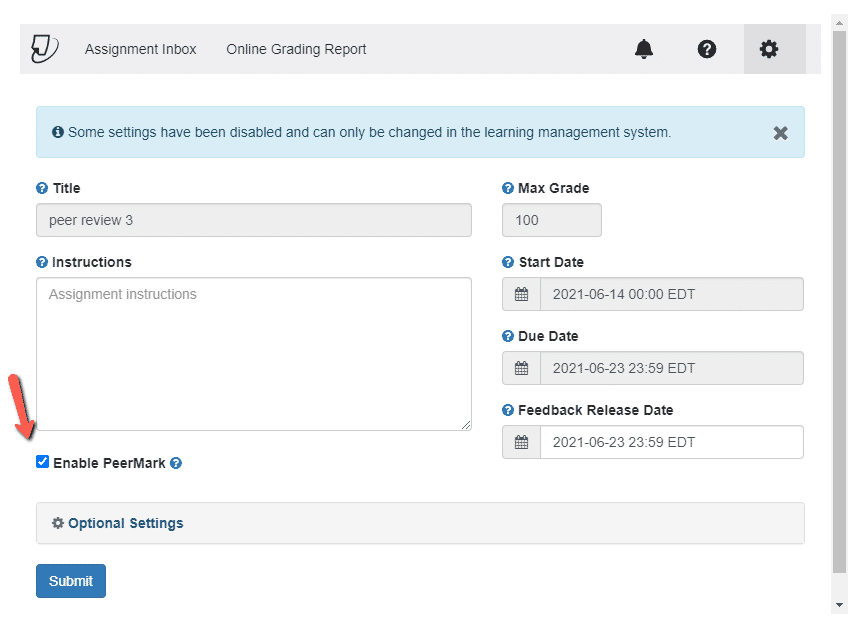
- 2. Set up PeerMark
Once PeerMark is enabled, you will see a PeerMark tab show on the top of the page. It has a drop-down list that gives you two options: PeerMark Setup and PeerMark Reviews (see the screenshots below). You may choose PeerMark Setup to customize how and when students should do the peer reviews. Peer reviews can be automatically assigned, you may allow students to choose which submission they would like to review. You can also decide whether the peer reviews are anonymous or attributed.
Please refer to the detailed instructions on how to set it up.
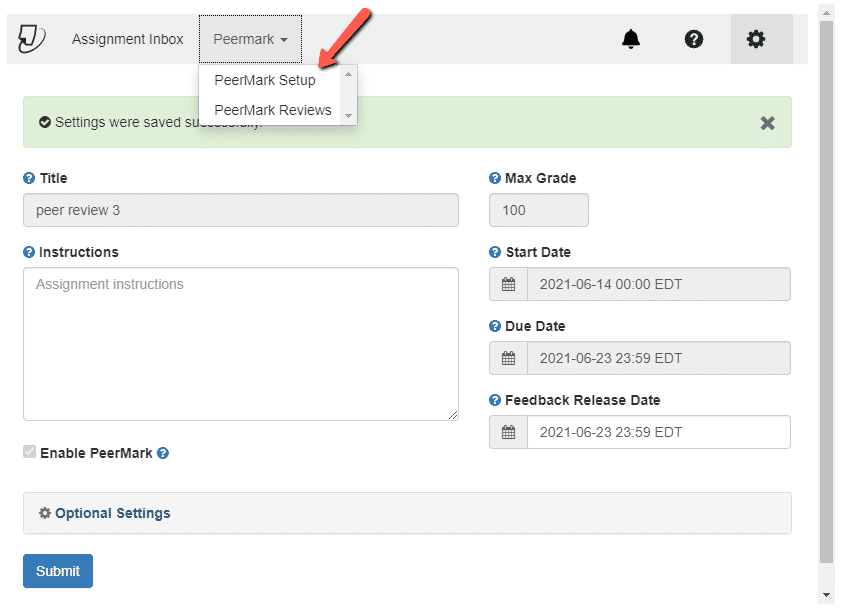
- 3. Create PeerMark Questions
When you create the assignment, you can choose to use a rubric for the peer review. The rubric can be used for scoring the assignment submissions by using the criteria and scales defined in the rubric. If you want your students to provide additional feedback, you may add specific questions to solicit responses. You may choose questions available in the library or create your own questions, which could be saved to the library for use in the future. Two question types are available: Free Response and Scale.
To learn more, please refer to this documentation on how to add PeerMark questions.

- 4. Review assignment instructions before publishing it
After you finish PeerMark setup, you can publish the assignment. However, we recommend that you review the instructions of the assignment to see if they provide students with clear information on what they are expected to do and how to do it for the peer reviews. Here is a checklist for you to consider regarding what to be included in the assignment instructions:
- When is the assignment due?
- When are students assigned to do the peer reviews?
- When are the peer reviews due?
- Are peer reviews assigned to students or do you allow them to select the peer reviews?
- How many assignment submissions will each student review?
- How are students expected to do the peer reviews? For example, are they supposed to respond to any questions? Should they provide inline comments?
- Are the peer reviews anonymous?
- Does students' evaluation of the assignment submission count for its grade?
- Do students get credit for completing the peer reviews?
- Are there any instructions you can provide to your students regarding how to do the peer reviews? - The section below, How does it work for students? provides resources that you can provide to your students.
- 5. Provide instructor feedback
Besides having students review and provide feedback on the assignment submissions, you may provide your feedback as the instructor.
This video tutorial demonstrates how to use QuickMarks and other commenting tools to provide feedback.
- 6. Verify and review students' peer reviews
You can verify if students have completed the peer reviews assigned to them and review the feedback they provided. Please watch this video tutorial for more details.
Instructor Guides
The instructor guides on the Turnitin website provides help documentation on creating and managing Turinit assignments, using and interpreting similarity report, as well as setting up and managing PeerMark.
How does it work for students?
The PeerMark assignments allow students to read, review, and evaluate assignments submitted by their peers. The basic stages of the PeerMark peer review process are:
- Submit a Turnitin assignment in Canvas - We recommend that you have the assignment submission checked for its originality, grammar, spelling, etc. Students could use the reports generated from Turnitin to improve their assignments before submitting the final version. That means you need to allow multiple submissions before the assignment is due. Here is a video tutorial on how students submit a Turnitin assignment and view the originality and e-rator reports.
- Conduct Peer Reviews - This tutorial demonstrates how students can use QuickMarks and other commenting tools to conduct peer reviews and provide feedback in a PeerMark assignment.
- View and rate peer feedback - After the peer reviews are released, students can view the feedback they received from their peers. They can also rate the helpfulness of the review by selecting a number on a scale from 0 to 10. Here are instructions on how students view and rate peer feedback
Student Guides
The student guides on the Turnitin website provide help documentation for students on how to submit a Turnitin assignment, interpret the similarity report and the e-rator feedback, and how to conduct peer review and provide feedback in a PeerMark assignment.
Technology for Peer Review: Canvas Peer Reviews
How does it work for instructors?
Introduction
The Assignments tool in Canvas gives you an option of requiring peer reviews. Setting up the peer reviews takes a few steps:
- Enable peer reviews when creating a new assignment.
- Manually or automatically assign peer reviews.
- Decide whether the peer reviews will be anonymous or not.
- Save the assignment draft.
- Add a rubric for peer reviews.
- Review the instructions of the assignment before publishing it.
- Verify and view students' peer reviews.
Enable peer reviews when creating a new assignment
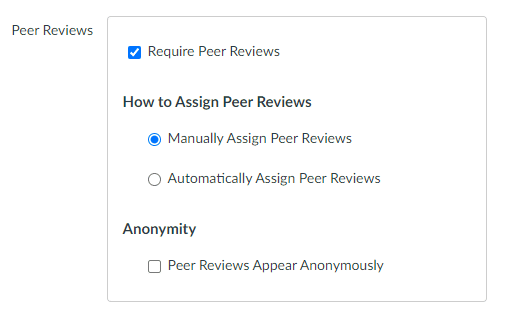
When creating an assignment, you can require students to review submissions of this assignment by other students and provide feedback What you need to do is check the box next to Require Peer Reviews in the assignment settings.
Manually or automatically assign peer reviews
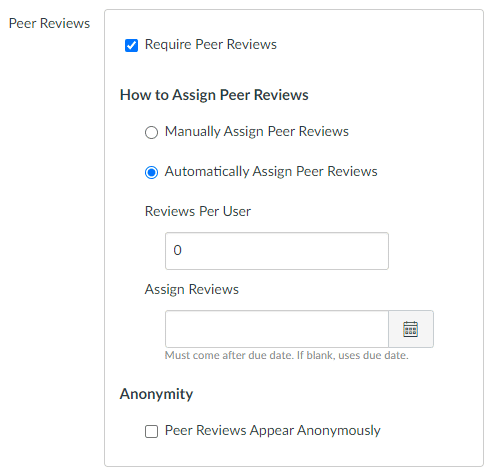
You have two options when assigning peer reviews:
- Manually assign peer reviews: Choose this option if you want to assign a particular student to review another. Here are instructions on how to do it.
- Automatically assign peer reviews: If you choose this option, Canvas will randomly assign peer reviews for you. You need to decide how many reviews each student needs to complete, and enter the date when the peer reviews will be assigned. The Assign Reviews date must come on or after the assignment due date. If left blank, Canvas will use the assignment due date. Here are instructions on how to do it.
Note: When automatically assigning peer reviews, students will not be assigned peer reviews or see their assigned peer reviews until they have submitted their own assignment. When manually assigning peer reviews, students can complete their assigned peer reviews without having to submit their own assignment first.
Decide whether the peer reviews will be anonymous or not
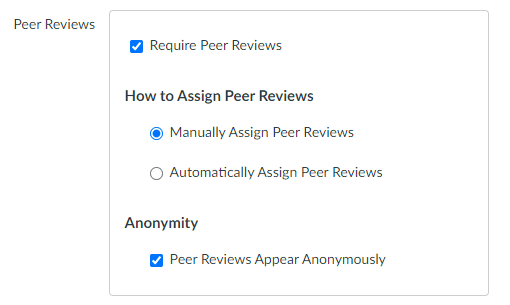
If you want to make peer reviews anonymous, check the box next to Peer Reviews appear Anonymously. Anonymous peer review is a double-blind process. The reviewer cannot see the name of the assessee, and the assessee cannot identify the reviewer.
Save the assignment draft

Once you finish configuring the assignment settings, you may save a draft of the assignment by clicking the Save button. We do not publish the assignment at this time because there is one more thing to do, adding a rubric for the peer reviews. This step cannot be done until we save the draft.
Add a rubric for peer reviews
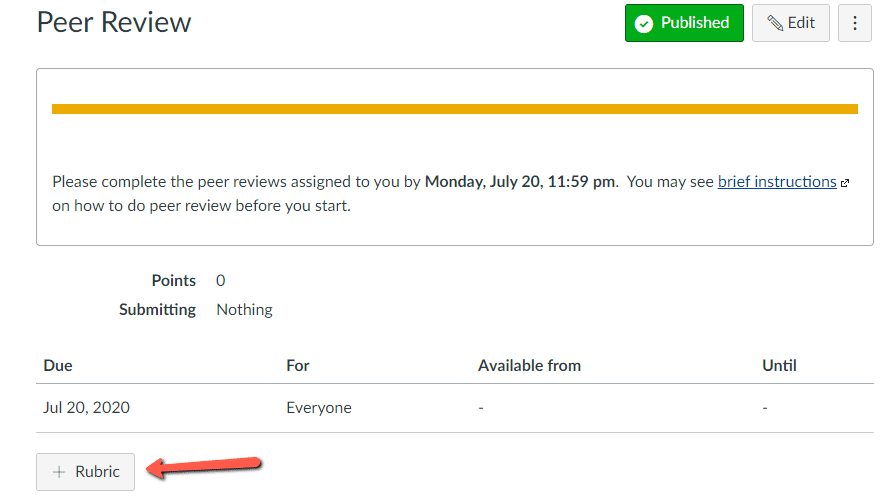
After you save the assignment draft, you can see that you have the option of adding a rubric that students can use for evaluating their peers' work. Using a rubric can help guide students' peer reviews by providing them with criteria that are clearly defined for the evaluation. Here are instructions on how to create and add a rubric for assignments.
Review the instructions of the assignment before publishing it
After you add the rubric for the peer reviews, you can publish the assignment. However, we recommend that you review the instructions of the assignment to see if they provide students with clear information on what they are expected to do and how to do it for the peer reviews. Here is a checklist for you to consider regarding what to be included in the assignment instructions:
- When is the assignment due?
- When are students assigned to do the peer reviews?
- When are the peer reviews due? - Note that you can only set the due date for the assignment submission in the settings. You have to provide the due date of the peer reviews in the instructions.
- How many reviews will be assigned to each student?
- How are students expected to do the peer reviews? For example, is there a rubric for them to use? If yes, are they supposed to write comments in addition to evaluating the assignment with the rubric?
- Are the peer reviews anonymous?
- Does students' evaluation of the assignment submission count for its grade?
- Do students get credit for their peer reviews? - The peer reviews assignment won't allow you to assign a grade for students who completed the peer review. However, you may create a no-submission assignment and assign students a grade for completing the task.
- Are there any instructions you can provide to your students regarding how to do peer reviews in Canvas? - The section below, How does it work for students? provides resources that you can provide to your students.
Verify and view students' peer reviews
You can verify if students have completed an assigned peer review in the peer review page. You can also use SpeedGrader to view how each student evaluated the assignment submission by using the rubric, and what comments they provided. Here are instructions on how to verify and view students' peer reviews.
Instructor Guide
- How do I use peer review assignments in a course?
- How do I create a peer review assignment?
- How do I manually assign peer reviews for an assignment?
- How do I automatically assign peer reviews for an assignment?
- How do I view student peer review comments as an instructor?
How does it work for students?
A peer review assignment does not look any different to students than other Canvas assignment that does not require peer reviews. Therefore, students will submit the assignment the way they usually do for any assignments. The peer reviews are not assigned to the students until after the assignment is due.
The video tutorial below demonstrates how students conduct peer reviews in Canvas:
In summary, here are three essential things that student need to know about peer reviews:
- How do students know when a peer review is assigned to them?
Once a peer review is assigned to students, they will be notified about the task via email. Please note that how they receive the email notification depends on how they set up their notification preferences.
Students can also view a notification in three areas within the Canvas course site:
The To Do list on the right sidebar of the page right after they log on to Canvas and the course site Recent Activity in the course site The individual assignment page
How do I know if I have a peer review assignment to complete?
You can provide the link below to students for related instructions:
- How do students submit a peer review to an assignment?
The process of peer reviews is similar to what instructors would do when they grade assignments. If the assignment submission is a file supported by Canvas DocViewer, it can be rendered in SpeedGrader, which is a tool for grading assignments and quizzes and providing feedback within the submissions. Students can use the markup tools of the SpeedGrader to provide annotated comments on the assignment submissions.
If a rubric is provided for the peer reviews, students could score the assignment by using the criteria defined in the rubric. Please note that the score does not get entered into the gradebook. Only the instructor can actually grade the assignment.
Adding comments on each score on the rubric is optional, but could be encouraged because it is an opportunity for the reviewers to explain why they gave a certain score for each criterion. Please note that the annotated comment would not be anonymous so it should not be used for anonymous peer reviews.
In addition, overall comments can be added by typing in a comment box or attaching a separate document. Video or audio comments can be recorded and attached.
You can provide the link below to students for related instructions:
- How do students view feedback from peer reviewers?
Students can find peer feedback on their assignment submissions in several places. First, there is a notification under Recent Feedback on the right sidebar in Canvas. They can go to Assignments and open that particular assignment to view the feedback.
You can provide the link below to students for related instructions:
Where can I find my peers' feedback for peer reviewed assignments?
Canvas Peer Reviews vs. Turnitin PeerMark
You just learned how to use Canvas Peer Reviews and Turnitin PeerMark for peer review assignments. They have some features in common, but each seems to have something unique. You might be thinking: which tool should I use? To help you make decisions, we do a side-by-side comparison of these two tools in what they enable you to do in terms of these four aspects:
- Schedule peer reviews
- Assign peer reviews
- Conduct peer reviews
- Assess peer reviews
You can download the 2-page feature comparison below to learn more details.
Strategies for Using Peer Review Effectively
Make it transparent
Purpose, task, and criteria are three components of the Transparency Framework for creating assignments. This framework can be applied to peer review. You should communicate with students about the key benefits, the purposes, the process, and the criteria of peer review, which will help students take this task seriously and put efforts into it.
Consider students' workload
You need to consider students' appropriate workload when you decide how many reviews should be assigned to each student and when the peer review will be completed. Having to review too many submissions within a short time could affect the quality of the feedback provided.
Use rubrics or provide question prompts
Develop a rubric to guide students' review: what to be reviewed and what criteria are to be used for the review. Go over the rubric with students and address questions they may have on applying the rubric criteria to their review. If you do not use a rubric, you may consider asking a few free-response and/ or scale questions to guide students' peer reviews.
Offer guidance on providing good feedback
Provide students with guidelines on how to provide good feedback. Model the respectful, informative, and constructive commentary that you expect of your students. You may use the RISE model as a guide for providing quality peer feedback:
Reflect (Recall, Ponder, and Communicate):
- I relate/concur/disagree with X because…
- I like what you did with X because…
Inquire (seek information and/or provide ideas through questioning):
- Have you considered looking at X from Y perspective?
- When you said X, am I understanding that you meant XY?
Suggest (introduce ideas for improvement of current iteration):
- You might want to consider tweaking X for Y effect…
- You might want to include supporting information for X resource …
Elevate (raise a higher degree or purpose in future iterations):
- Perhaps you can expand on this in X fashion to further address Y…
- Perhaps you can re-purpose X as Y for Z…
Provide help guides on using the peer review tool
Assume your students do not know how and provide help guides on how to use the peer review tools. You may use the student guides included in the previous sessions.
Allow revision and resubmission
Provide students an opportunity to revise their work based on the feedback they received and resubmit their improved product.
Recommended Resources
- Using Peer Review to Improve Student Writing: This is a comprehensive guide on using peer review from the University of Michigan. Although it is focused on using peer review to improve student writing, the strategies and techniques could be applied in other disciplines.
- Using Student Peer Review in Any Class: This resource compiled by the Center for Teaching Excellence at the University of Waterloo summarizes the Why and How of using peer review in any class. It also provides a list of other resources and further readings.